<< Previous | Displaying results 2501-2550 of 6769 for "" | Next >>
Victor Brack, one of the Nazi doctors on trial for having conducted medical experiments on concentration camp prisoners. Nuremberg, Germany, August 1947.
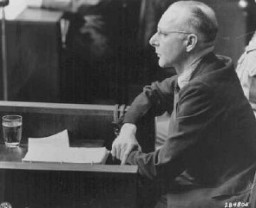
SS chief Heinrich Himmler (left) and Hans Frank, head of the Generalgouvernement in occupied Poland. Krakow, Poland, 1943.
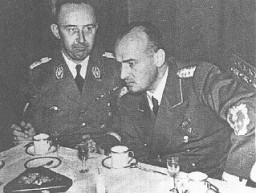
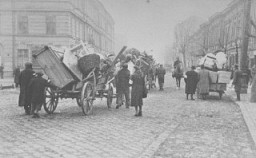
Shimshon and Tova Draenger, members of the underground in the Kraków and Warsaw ghettos and partisans in the Wisnicz Forest. Krakow, Poland, date uncertain.
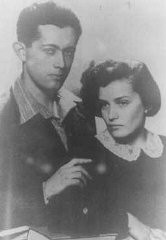
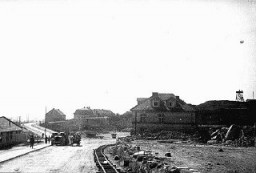
Prisoners receive meager food allocations at the Plaszow camp. Krakow, Poland, 1943 or 1944.
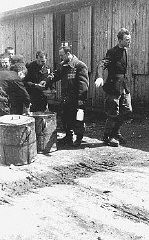
Amon Goeth (front left), commandant of the Plaszow camp, under escort to the courthouse in Kraków for sentencing. He was sentenced to death at his postwar trial on war crimes charges. Kraków, Poland, August 1946.
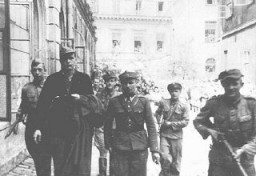
A mass grave dug by Jewish forced laborers for the bodies of individuals murdered by the NKVD in Lvov prisons. The NKVD (Soviet secret police) murdered thousands of Ukrainian nationalists, as well as some Jews and Poles, before retreating from the Nazi invasion. The Germans and their Ukrainian collaborators then used the massacre as a pretext for anti-Jewish pogroms, claiming that the Jews had helped the secret police. Lvov, Poland, July 3, 1941.
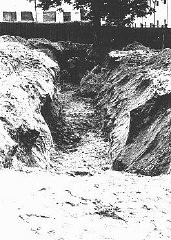
Members of the Lvov Jewish council are hanged by the Germans. Lvov, Poland, September 1942.
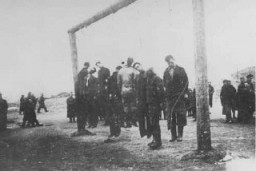
Shoes of victims in the Janowska camp were found by Soviet forces after the liberation of Lvov. Janowska, Poland, August 1944.
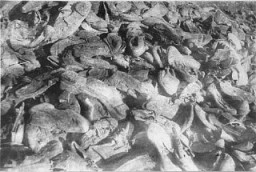
Residents of the Lublin ghetto. Poland, 1941-1942. (Source record ID: E9 NW 33/IV)
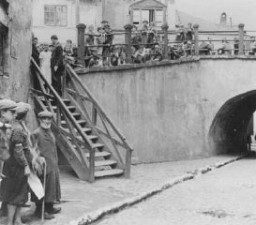
Lithuanian librarian Ona Simaite took food to Jews in the Vilna ghetto, helped hide many Jews outside the ghetto, and saved valuable Jewish literary and historical materials. Vilna, 1941.
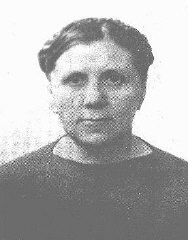
A group of Jewish partisans in the Rudniki forest, near Vilna, between 1942 and 1944.
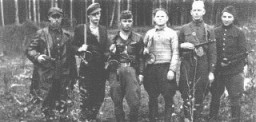
Located on Ulica Stara (Old Street), outside the Vilna ghetto, this building was used as a safe house by the ghetto resistance. Vilna, after July 1944.
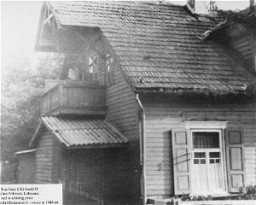
Abba Kovner (center) poses with Ruska Korczak (left) and Vitka Kempner (right) on a street in Vilna the day of the city's liberation.
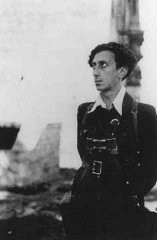
Family and friends are gathered for a Jewish wedding celebration in Kovno. Among those pictured are Jona and Gita Wisgardisky (standing at the back on the right). In the summer of 1941 soon after the German occupation of Lithuania, the Wisgardisky family was forced into the Kovno ghetto. During a roundup of children in the ghetto in 1942, Henia (Gita and Jona's daughter) was hidden in a secret room that her father built in a pantry in their apartment. Later she was smuggled out of the ghetto and…
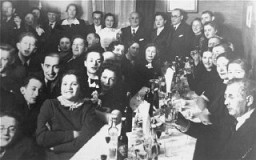
A group of children in the Kovno ghetto in Lithuania. This photograph was taken by George Kadish between 1941 and 1943.
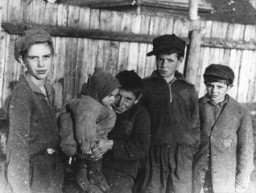
Jewish women return to the Kovno ghetto after forced labor on the outside. They line up to be searched by German and Lithuanian guards. Kovno, Lithuania, between 1941 and 1944.
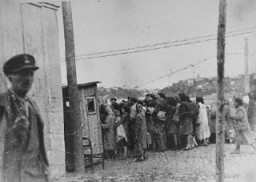
Photograph taken by George Kadish: a member of the Kovno ghetto underground hides supplies in a well used as the entrance to a hiding place in the ghetto. Kovno, Lithuania, 1942.
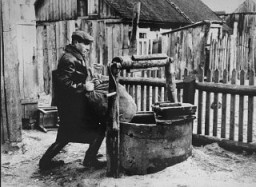
Deportation of Jews from the Kovno ghetto to a work camp. Lithuania, 1942.
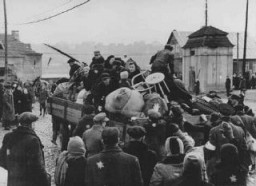
This clandestine photograph taken by George Kadish captures a scene during the deportation of Jews from the Kovno ghetto in German-occupied Lithuania in 1942.
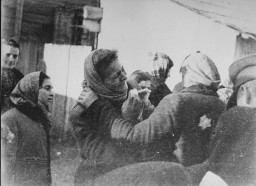
An assortment of antisemitic handbills, posters, and stickers from Germany, 1919.
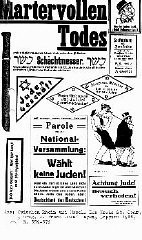
A pedestrian stops to read an issue of the antisemitic newspaper Der Stuermer (The Attacker) in a Berlin display box. "Der Stuermer" was advertised in showcase displays near places such as bus stops, busy streets, parks, and factory canteens throughout Germany. Berlin, Germany, probably 1930s.
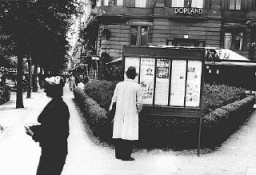
During the anti-Jewish boycott, SA men carry banners which read "Germans! Defend Yourselves! Do Not Buy From Jews!" Berlin, Germany, March or April 1933.
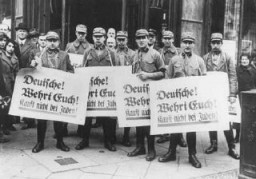
An SA member instructs others where to post anti-Jewish boycott signs on a commercial street in Germany. A German civilian wearing a Nazi armband holds a sheaf of anti-Jewish boycott signs, while SA members paste them on a Jewish-owned business. Most of the signs read, "Germans defend yourselves against Jewish atrocity propaganda/Buy only at German stores." Germany, ca. April 1, 1933.
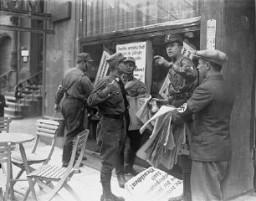
A sign outside a town in northern Bavaria warns: "City of Hersbruck. This lovely city of Hersbruck, this glorious spot of earth, was created only for Germans and not for Jews. Jews are therefore not welcome." Hersbruck, Germany, May 4, 1935.
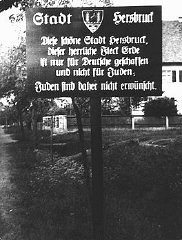
A motorcyclist reads a sign stating "Jews are not welcomed here." Germany, ca. 1935.
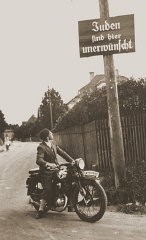
Illustration from an antisemitic children's book. The sign reads "Jews are not wanted here." Books such as this one used antisemitic caricatures in an attempt to promote Nazi racial ideology. Germany, 1936.
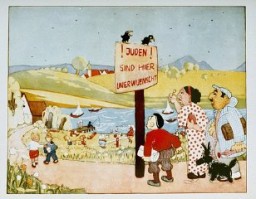
Illustration from a German antisemitic children's book titled Trust No Fox in the Green Meadow and No Jew on his Oath (translation from German). The headlines depicted in the image say "Jews are our misfortune" and "How the Jew cheats." Germany, 1936.
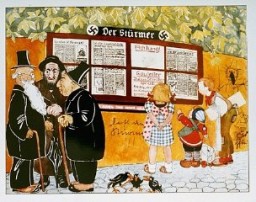
Page from Der Giftpilz (The Poisonous Mushroom). This photograph shows a page from one of several antisemitic children's books published by Julius Streicher's Der Stürmer-Verlag, used for indoctrinating youth. The text reads, "The Jewish nose is crooked at its tip. It looks like the number 6."
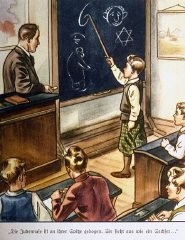
Cover of an antisemitic German children's book titled Trust No Fox in the Green Meadow and No Jew on his Oath, published by Der Stürmer-Verlag (publishing company of Julius Streicher). Germany, 1936.
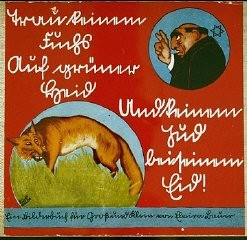
German boys read an issue of Der Stuermer newspaper posted in a display box at the entrance to a Nazi Party headquarters in the Dresden region. The German slogan (partially obscured) at the bottom of the display box reads, "The Jews are our misfortune."
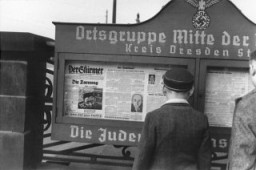
An anti-Jewish sign posted on a street in Bavaria reads "Jews are not wanted here." Julien Bryan took this photograph while visiting Germany in 1937. Back in the United States, Bryan regularly gave lectures with accompanying motion pictures to convey the looming dangers he foresaw in Europe. During one of these presentations in 1938, he said: "And then a sign like this. Along the Rhine you see these signs against the Jew everywhere, … all through central and southern Germany, saying simply and…
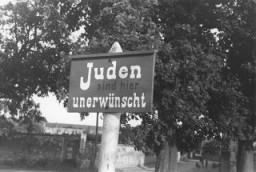
Poster for the antisemitic museum exhibition Der ewige Jude (The Eternal Jew) characterizes Jews as Marxists, moneylenders, and enslavers. Munich, Germany, November 8, 1937. Nazi propagandists also created a film of the same name.
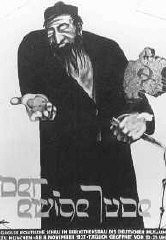
Shortly after the German annexation of Austria, Nazi Storm Troopers stand guard outside a Jewish-owned business. Graffiti painted on the window states: "You Jewish pig may your hands rot off!" Vienna, Austria, March 1938.
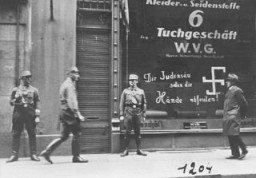
A woman who is concealing her face sits on a park bench marked "Only for Jews." Austria, ca. March 1938.
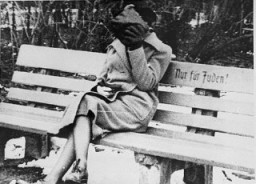
Viennese pedestrians view a large Nazi sign posted on a restaurant window informing the public that this business is run by an organization of the Nazi Party and that Jews are not welcome. Vienna, Austria, March-April 1938.
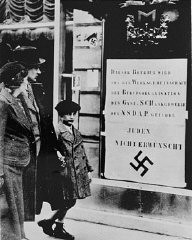
Antisemitic graffiti painted on the wall of a Jewish cemetery reads "The death of the Jews will end the Saarland's distress." Berlin, Germany, November 1938.
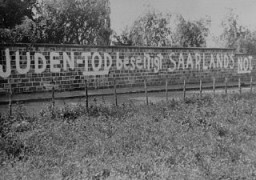
A Jewish-owned cafe in Vienna that was defaced with antisemitic graffiti. Vienna, Austria, November 1938.
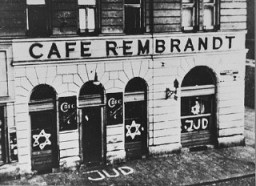
Cover of a German antisemitic book for children, Der Giftpilz (The Poisonous Mushroom), published in Germany by Der Stuermer-Verlag.
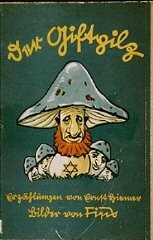
Sign on a phone booth in Munich that prohibits Jews from using the public telephone. Munich, Germany, 1942.
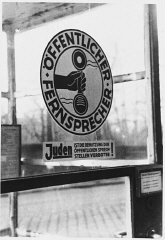
Anne Frank at 11 years of age, two years before going into hiding. Amsterdam, the Netherlands, 1940.
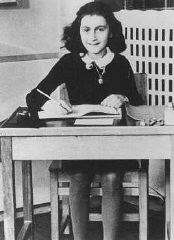
Haika Grosman, one of the organizers of the Bialystok ghetto underground and participant in the Bialystok ghetto revolt. Poland, 1945.

Jewish parachutist Hannah Szenes with her brother, before leaving for a rescue mission. Palestine, March 1944. Between 1943 and 1945, a group of Jewish men and women from Palestine who had volunteered to join the British army parachuted into German-occupied Europe. Their mission was to organize resistance to the Germans and aid in the rescue of Allied personnel. Hannah Szenes was among these volunteers. Szenes was captured in German-occupied Hungary and executed in Budapest on November 7,…
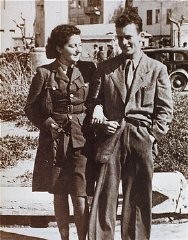
Jewish parachutist Hannah Szenes at Kibbutz Sedot Yam, a communal agricultural settlement. Palestine, 1941.
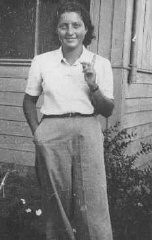
Prewar photo of Ala Gertner. Bedzin, Poland, 1930s. After being deported to Auschwitz, Ala Gertner took fate into her own hands. Upon arrival, she was assigned to forced labor at a nearby armaments factory. After learning that they were going to be killed, Gertner, along with fellow female prisoners, began smuggling gunpowder and explosives from the factory with plans to destroy one of the crematoriums. During the uprising in October 1944, the prisoners killed three guards. They also set fire to…
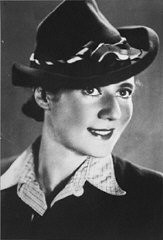
Jewish women sort confiscated clothing in the Lodz ghetto. Photograph taken by Mendel Grossman between 1941 and 1944. Mendel Grossman photograph collection
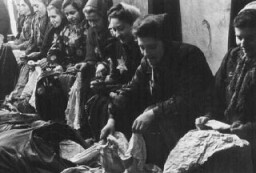
Hildegard Kusserow, a Jehovah's Witness, was imprisoned for four years in several concentration camps including Ravensbrück. Germany, date uncertain.
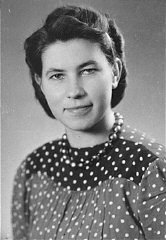
Women prisoners pull dumpcars filled with stones in the camp quarry. Plaszow camp, Poland, 1944.
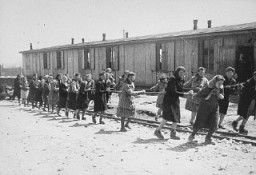
View of barracks in the women's camp in the Auschwitz-Birkenau killing center in German-occupied Poland, 1944.
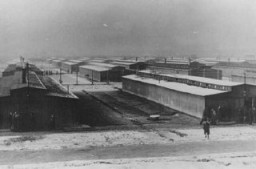
We would like to thank Crown Family Philanthropies, Abe and Ida Cooper Foundation, the Claims Conference, EVZ, and BMF for supporting the ongoing work to create content and resources for the Holocaust Encyclopedia. View the list of donor acknowledgement.